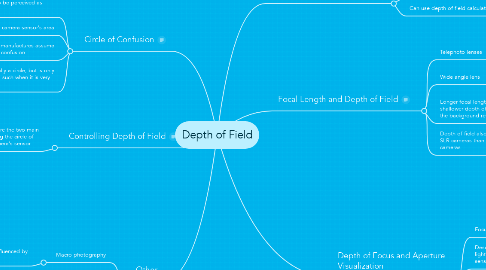Depth of Field
by Alyssa Barrios


1. Circle of Confusion
1.1. Used to define how much a point needs to be blurred in order to be perceived as unsharp
1.2. A tiny fraction of the camera sensor's area
1.3. A camera manufactures assume a circle of confusion
1.4. Usually not actually a circle, but is only approximated as such when it is very small
2. Focal Length and Depth of Field
2.1. Telephoto lenses
2.1.1. Creates a much shallower depth of field
2.2. Wide angle lens
2.2.1. The total depth of field is virtually constant with focal length
2.3. Longer focal lengths may also appear to have a shallower depth of field because they enlarge the background relative to the foreground
2.3.1. Can make an out of focus background look even more out of focus
2.4. Depth of field also appears shallower for SLR cameras than for compact digital cameras
3. Calculating Depth of Field
3.1. To calculate decide on an appropriate value for the maximum allowable circle of confusion
3.2. Can use depth of field calculator
4. Controlling Depth of Field
4.1. Aperture and focal distance are the two main factors that determine how big the circle of confusion will be on your camera's sensor
5. Depth of Focus and Aperture Visualization
5.1. Focus spread
5.2. Describes the distance over which light is focused at the camera's sensor
5.3. When an object is in focus, light rays originating from that point converge at a point on the camera's sensor
6. Other
6.1. Macro photography
6.1.1. Depth of field is influenced by pupil magnification
6.1.1.1. pupil magnification is usually not provided by lens manufacturers
6.2. Diffraction
6.2.1. More of a limiting factor than depth of field as the aperture gets smaller
